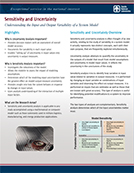Understanding the input and output variability of a system model

Sensitivity and uncertainty analysis is often thought of as one activity, relating to the study of variability in a system model. It actually represents two distinct concepts, each with their own purpose, that are frequently explored simultaneously. Uncertainty analysis attempts to quantify the uncertainty in the outputs of a model that result from model assumptions and uncertainty in model input values. It reflects the uncertainty in the conclusions of the study. Sensitivity analysis tries to identify how variation in input values relates to variation in output measures. It is performed by changing an input variable or combinations of input variables and observing the effect on output measures. It is performed on inputs that are estimates as well as those that are known with great accuracy. This type of analysis is useful for identifying potential modifications to a system to improve performance. The two types of analyses are complementary. Sensitivity analysis determines which input uncertainties matter most.
Why is uncertainty analysis important?
- Provides decision makers with an assessment of overall model accuracy
- Documents the variability in each input value
- Enables “rolling up” of uncertainty in input values into uncertainty in output measures
Why is sensitivity analysis important?
- Investigates the robustness of the model
- Allows the modeler to assess the impact of modeling assumptions
- Determines which of the modeling input uncertainties have the greatest effect on model output measure uncertainty
- Provides insight into how the system behaves in response to changes in input values
- Gives analysts understanding of the interaction of multiple input factors
What are the objectives for developing this capability?
- Quantify input and output variability and understanding their significance
- Identify which inputs require additional data collection or research to reduce system uncertainty
- Identify if subsystems can be simplified or require greater modeling fidelity
- Identify which parameters to improve in order to gain the most benefit
What are the research areas?
- Screening of variables to reduce model dimensionality
- Working with sparse data sets when little information is available
- Analyzing complex systems for improved resiliency
Fact Sheet

Click Fact Sheet to download PDF.